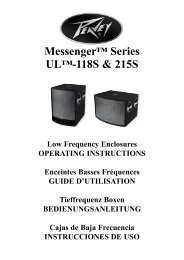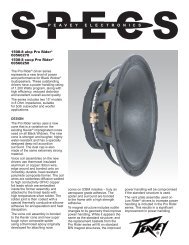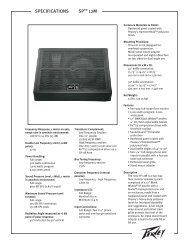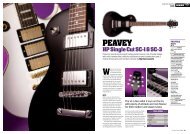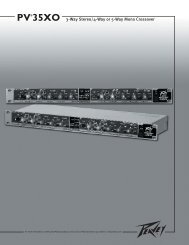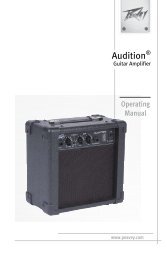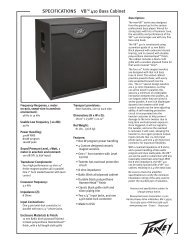Peavey ValveKing VK112 combo
Peavey ValveKing VK112 combo
Peavey ValveKing VK112 combo
Create successful ePaper yourself
Turn your PDF publications into a flip-book with our unique Google optimized e-Paper software.
THE GUITAR PLAYER’S BIBLE<br />
<strong>Peavey</strong> <strong>ValveKing</strong><br />
<strong>VK112</strong> <strong>combo</strong>
PEAVEY VALVEKING <strong>VK112</strong> COMBO £349<br />
GUITAR AMPS<br />
The rivals<br />
Vox AC30CC 1 x 12 £649<br />
Randall RG50TC 1 x 12<br />
£499<br />
Marshall DSL 401 1 x 12<br />
<strong>combo</strong> £539<br />
Vox’s AC30 Custom<br />
Classic range has cool<br />
styling with some neat<br />
boutique features, but<br />
this Chinese-made<br />
AC30 is comparatively<br />
pricey and its somewhat<br />
narrow tonal range<br />
means it’s most likely<br />
to suit Vox enthusiasts.<br />
Randall’s RG50TC was<br />
a strong performer in<br />
our recent review and<br />
sounds superb – it’s<br />
easily capable of outclassing<br />
some amps<br />
that cost twice as much,<br />
however the <strong>ValveKing</strong>’s<br />
pricing means the<br />
Randall doesn’t look<br />
as good as it did in the<br />
value for money stakes.<br />
Marshall’s stalwart<br />
DSL401 has been the<br />
beginner’s first choice<br />
for many years, but is<br />
now looking decidedly<br />
tired and overpriced in<br />
this very competitive<br />
sector of the market. If<br />
you want the Marshall<br />
sound and badge then<br />
it won’t disappoint,<br />
but there’s a lot more<br />
choice now and the<br />
impact of Chinese-made<br />
pricing can’t be ignored<br />
PHOTOGRAPHY JOBY SESSIONS<br />
<strong>Peavey</strong> <strong>ValveKing</strong> <strong>VK112</strong> <strong>combo</strong> £349<br />
I<br />
t was only a matter of time before<br />
one of the major players in guitar<br />
amplification weighed in with a<br />
Chinese-made product and <strong>Peavey</strong>’s<br />
new <strong>ValveKing</strong> is the amp range that<br />
everyone’s been talking about.<br />
Combining cool boutique-inspired<br />
With features you won’t find on<br />
some models costing twice as<br />
much, <strong>Peavey</strong> hasn’t undercut<br />
the competition, it’s<br />
comprehensively blown it away<br />
<strong>Peavey</strong>’s awesome <strong>ValveKing</strong> range is great news for everyone –<br />
apart from other manufacturers, that is by Nick Guppy<br />
features with pricing that will make<br />
almost every other amp manufacturer<br />
wince, the <strong>ValveKing</strong> has generated<br />
more than interest. So, apart from the<br />
price tag, what’s all the fuss about?<br />
Let’s take a look at the <strong>ValveKing</strong><br />
<strong>VK112</strong> <strong>combo</strong> and find out.<br />
The <strong>ValveKing</strong> range is designed in<br />
Meridian, USA, but made offshore in<br />
China. As we’ve recently seen with<br />
other Chinese-made products, this is<br />
no longer something that should be<br />
viewed with disdain or doubt – yes it’s<br />
built to a price, but the standard of<br />
construction is still what we would<br />
expect from <strong>Peavey</strong>.<br />
The cabinet is neatly clad in tough<br />
black vinyl with metal corner<br />
protectors, and a smart silver check<br />
grille-cloth covers the <strong>ValveKing</strong>’s<br />
special 12-inch loudspeaker. The<br />
electronics are contained within a<br />
sturdy open-tray steel chassis on four<br />
printed circuit boards – one large PCB<br />
holding all the main preamp and power<br />
supply components, another for the<br />
<strong>VK112</strong>’s pair of 6L6 output valves and<br />
12AX7 driver, with two smaller boards<br />
for mains and rear panel connections.<br />
These boards aren’t through-plated,<br />
but they’re robust and well-supported<br />
on metal standoffs – internal wiring is<br />
minimal and neatly routed, while the<br />
valve bases are all chassis mounted,<br />
which makes replacement easier. At<br />
this price it’s a good standard of<br />
construction that inspires confidence.<br />
The <strong>ValveKing</strong>’s front panel is easy to<br />
navigate. There’s a pair of high and low<br />
sensitivity input sockets feeding two<br />
channels with separate three-band<br />
EQs. Next to the clean channel’s single<br />
volume control are a pair of<br />
PEAVEY <strong>VK112</strong> COMBO TEST RESULTS<br />
Build quality<br />
Features<br />
Sound<br />
Value for money<br />
■ WE LIKED Great range of sounds;<br />
unbelievably low price; texture control adds<br />
considerable versatility<br />
■ WE DISLIKED A little over-gained for<br />
some; reverb could do with some taming<br />
pushbutton switches for toggling the<br />
amp’s bright function and changing<br />
channels, while another pair of buttons<br />
next to the overdrive channel’s gain<br />
control operate preset distortion and<br />
volume boost functions that can be<br />
used separately or together as<br />
required. The front panel tour finishes<br />
with a pair of jacks for the series effects<br />
loop and a master level control for the<br />
short Belton reverb spring.<br />
However, the <strong>ValveKing</strong>’s real secret<br />
weapon is around the back in the shape<br />
of a knob <strong>Peavey</strong> calls the texture<br />
control. This is a new patent-pending<br />
feature that simultaneously varies the<br />
power stage’s sensitivity, response and<br />
‘break-up’ point. With the texture<br />
control set fully clockwise, the<br />
<strong>ValveKing</strong> is working in normal pushpull<br />
Class A/B operation. Then as you<br />
rotate the control anti-clockwise, one<br />
half of the output stage is progressively<br />
subtracted from the circuit, while the<br />
driver valve’s gain is increased and its<br />
The <strong>ValveKing</strong>’s<br />
speaker is a special<br />
design 1 x 12<br />
low frequency response altered to<br />
complement the change from odd to<br />
even-order harmonic emphasis. At<br />
fully anti-clockwise, the <strong>ValveKing</strong><br />
effectively transforms from push-pull<br />
class A/B to single-ended Class A, with<br />
around 60 per cent less output power<br />
and a completely different character.<br />
This clever feature can be fine-tuned<br />
with a resonance switch that varies low<br />
frequency response by altering the<br />
amp’s damping factor. The rear panel is<br />
also home to a handy extension<br />
speaker jack and a socket for the<br />
footswitch, which changes channels
PEAVEY VALVEKING <strong>VK112</strong> COMBO £349<br />
GUITAR AMPS<br />
The footswitch<br />
changes channels and<br />
toggles the volume/<br />
distortion boost<br />
PEAVEY VALVEKING<br />
<strong>VK112</strong> COMBO<br />
PRICE: £349<br />
ORIGIN: USA designed,<br />
Chinese built<br />
TYPE: All valve twochannel<br />
Class A/AB<br />
<strong>combo</strong> with solid-state<br />
rectification<br />
OUTPUT: Variable from<br />
approx 30-50W RMS<br />
VALVES: Three ECC83/<br />
12AX7, two 6L6 power<br />
amp<br />
DIMENSIONS: 460 (h)<br />
x 540 (w) x 260mm (d)<br />
WEIGHT (kg/lb): 21/44<br />
CABINET: MDF with ply<br />
baffle<br />
LOUDSPEAKER: One<br />
12-inch <strong>Peavey</strong><br />
<strong>ValveKing</strong> special design<br />
CHANNELS: Two<br />
CONTROLS: Clean<br />
channel: volume, bass<br />
mid, treble. Overdrive<br />
channel: gain, volume,<br />
bass, mid, treble, master<br />
reverb level.<br />
FOOTSWITCH: Twobutton<br />
footswitch<br />
changes channels,<br />
toggles preset volume/<br />
distortion boost function<br />
on overdrive channel<br />
ADDITIONAL<br />
FEATURES: Bright<br />
switch, footswitchable<br />
volume and boost presets<br />
for overdrive channel,<br />
series effects loop,<br />
texture control (varies<br />
power stage from Class<br />
A/B push-pull to Class A<br />
single ended), tight/loose<br />
resonance control,<br />
extension speaker jack<br />
(disconnects internal<br />
driver)<br />
OPTIONS: None<br />
RANGE OPTIONS: The<br />
100-watt <strong>ValveKing</strong><br />
VK212 <strong>combo</strong> also<br />
includes variable<br />
resonance and presence<br />
controls for just £449,<br />
while you can have the<br />
<strong>ValveKing</strong> VK100 head<br />
for just £349 with a<br />
matching VK412 cabinet<br />
for £249 – that’s a 100W<br />
half stack for under<br />
£600.<br />
<strong>Peavey</strong> Electronics<br />
01536 461234<br />
www.peavey.com<br />
and activates or defeats the boost<br />
functions preset on the front panel.<br />
SOUNDS: Switched on, the <strong>ValveKing</strong><br />
is quiet and hum-free – always a good<br />
sign. The clean channel has a warm,<br />
rounded character that’s especially<br />
friendly to single-coil guitars – we got<br />
the best results with all three tone<br />
controls set around the halfway mark.<br />
The bright switch really works, so if<br />
your axe has mid-range-heavy<br />
humbuckers you’ll approve of the extra<br />
twang this feature injects. Push the<br />
clean channel’s volume control beyond<br />
the halfway mark,<br />
add a little reverb<br />
and you’ll get a<br />
smooth overdrive<br />
that’s good for blues<br />
or country soloing<br />
and easily controlled<br />
from the guitar. Back<br />
off a little and it<br />
cleans up nicely for<br />
chords, or push it up<br />
for lead breaks.<br />
Distortion fiends won’t be<br />
disappointed with the <strong>ValveKing</strong>’s<br />
USA-flavoured overdrive channel.<br />
Even without using the boost feature<br />
there’s a ton of filth on tap, while<br />
engaging it will take even the weediest<br />
of pickups into almost endless sustain.<br />
Some players may even find this<br />
channel slightly over-gained. It’s still<br />
great fun to play unaccompanied with<br />
extreme distortion, however, in a live<br />
band context there’s some loss of<br />
The texture control is<br />
very powerful and at gig<br />
levels it makes a profound<br />
difference to the way the<br />
<strong>ValveKing</strong> responds – you<br />
can really hear the<br />
change in headroom<br />
definition with the controls maxed out.<br />
But apart from a few very expensive<br />
exceptions, almost all ultra-high gain<br />
valve amps do this and it’s one reason<br />
why many metal players use solid-state<br />
for their overdrive requirements.<br />
It doesn’t detract from the great<br />
sounds that can be pulled from the<br />
<strong>ValveKing</strong> using more realistic control<br />
settings. We actually found the best<br />
results with the gain level set to around<br />
4. At this low-ish setting the <strong>ValveKing</strong><br />
is still far from restrained, with plenty<br />
of bite and sustain to satisfy for ripping<br />
blues or rock solos, while the boost and<br />
volume presets add<br />
the versatility of a<br />
three-channel set-up<br />
without any of the<br />
complication. You<br />
can use the<br />
unboosted sound as<br />
a powerful crunch<br />
channel, then hit the<br />
footswitch for extra<br />
distortion, volume or<br />
both to punch your<br />
solos through the mix. The texture<br />
control is very powerful and at gig<br />
levels it makes a profound difference to<br />
the way the <strong>ValveKing</strong> responds – you<br />
can really hear the change in headroom<br />
as the knob is turned, along with the<br />
shift in character from class A/B bold<br />
and punchy to thick and compressed<br />
Class A. Combine this with the<br />
resonance control and you’ve got a lot<br />
of tone that stays useful from almost<br />
bedroom level up to indecently loud –<br />
easily enough to cope with small to<br />
medium no-PA gigs.<br />
The reverb level’s range is more than<br />
most people will need and, while it<br />
tended to get a little splashy at higher<br />
settings on both channels, at around<br />
one quarter it adds a nice halo to single<br />
notes and chords.<br />
Verdict<br />
The <strong>ValveKing</strong> is a great design from<br />
<strong>Peavey</strong> with some unique features that<br />
not only set it apart from the crowd but<br />
also make it an amp that new players<br />
won’t quickly outgrow. Experienced<br />
players and professionals should also<br />
make a point of checking this amp out:<br />
it’s solidly built, versatile and quick to<br />
dial in, and the low noise threshold<br />
makes it equally handy in the studio,<br />
where the Class A end of the texture<br />
control’s range can be used to get<br />
blistering hot overdrive at fairly<br />
painless volume levels. And, if any<br />
more persuasion were needed, there’s<br />
the price. At just under £350 for this<br />
1 x 12 <strong>combo</strong> version, <strong>Peavey</strong> hasn’t<br />
undercut the competition, it’s<br />
comprehensively blown it away.<br />
Remember, this is an all-valve amp with<br />
features you won’t find on some models<br />
costing twice as much. It’s brilliant<br />
value for money and, for the moment at<br />
least, we reckon the <strong>ValveKing</strong> is easily<br />
the best entry level valve amp money<br />
can buy.<br />
<strong>Peavey</strong> <strong>ValveKing</strong> <strong>VK112</strong><br />
RATING<br />
Fans of distortion<br />
will certainly not be<br />
disappointed with<br />
the <strong>ValveKing</strong>’s<br />
overdrive channel




